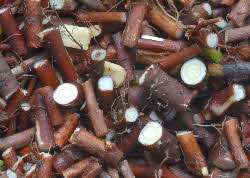Saponaria officinalis
 Soapwort leaves and roots are rich in saponins which produce a lather in water and can be used for washing in place of modern soaps and detergents. Soapwort leaves and roots are rich in saponins which produce a lather in water and can be used for washing in place of modern soaps and detergents.
1. Biology of Soapwort
2. Soapwort Cultivation
3. Uses for soapwort
4. Soapwort history
5. Using soapwort roots
6. Storing the soapwort roots
7. Using Soapwort leaves
8. Health & Safety
1. Biology of Soapwort
Soapwort (Saponaria officinalis) is a member of the pink family and a hardy perennial that spreads vigorously and can become invasive. The plants do not really need support even though they tend to flop after a while. Soapwort flowers from June to September, bearing sprays of pink flowers that smell of clover and the flowers are attractive to butterflies. The double-flowered form of Soapwort found in gardens is also known as Bouncing Bett.
2. Soapwort Cultivation
a) Soapwort seeds benefit from a short period when they are exposed to both cold and moisture (a process known as seed stratification), which breaks the seed dormancy. Sow seeds in the autumn and they should germinate in about four weeks. Prick out the seedlings into pots when large enough to handle and plant them out later in the year.
b) Division – it is very easy to divide soapwort plants at any time during the growing season providing you keep the divided plants well watered until they are established.
3. Uses for soapwort
a) To waterproof wool: You can use soapwort for washing fleece, instead of detergents that strip the lanolin from the fleece. Washing with soapwort retains some natural lanolin on the wool, helping to make the wool more water repellent. This washing method maybe useful if you plan to spin wool for an outdoor jumper or bag.
b) For textile conservation: Museum conservators use soapwort for cleaning delicate fabrics that can be harmed by modern synthetic soaps.
4. Soapwort History
In the Stone Age (12,000 years BC) or even earlier it is likely that when people went to wash their hands in the stream they grabbed the leaves of plants growing nearby to help scrub off the dirt. Soapwort grows near streams and the lather from its leaves would help cleaning. More recently soapwort was cultivated as a useful plant in Roman gardens and around Roman baths, whilst soapwort was also used to clean and prepare the Turin Shroud.
The first archaeological record of soap as we know it today is from nearly 5,000 years ago in Babylon. Babylonians made soap by mixing fats such as tallow or oil, such as olive oil, with water made alkaline with hardwood ashes. The first detergents, such as washing up liquid, were invented during the First World War.
 5. Using soapwort roots 5. Using soapwort roots
a) Dig the roots up and then chop them into 1 cm long pieces with secateurs.
b) Simmer the roots in water for about 20 minutes and let them cool.
c) Blend the roots in a liquidiser with water, using a handful of roots at a time. Be careful not to overload the liquidiser, which should be less than half full as the blending creates a great deal of foam. It is possible to crush the roots with a stone or mallet but this is slow and hard work.
d) Wait for the foam to subside, which can take several hours. I usually leave it overnight and then pour the liquid through a sieve to removes the bits of root. Remember that you want to save the liquid, so make sure that the sieve is over a container! It may be necessary to strain the remaining liquid through muslin to remove all the debris. If you are short of soapwort you can boil the bits of root again or dry them to re-use later.
e) Whisk the liquid with an electric or hand whisk. This will create lots of lovely, white, soapy foam.
6. Storing the soapwort roots
If you have more roots than you can use at one time, you can dry the chopped roots for later use. Be sure to keep turning the roots as they dry to prevent them from going mouldy.
7. Using Soapwort leaves
a) Crush fresh soapwort leaves with a rolling pin.
b) Simmer the leaves for about 10 minutes.
c) Strain the liquid, discard the leaves and then whisk the liquid until frothy.
If you are in a hurry you can crush the leaves with your hands and rub them on your hands for a quick alternative to soap.
8. Health & Safety
Soapwort can cause eye irritation when used as shampoo.
This plant should not be grown near a pond as saponins can be toxic to fish.
Top of page
|

